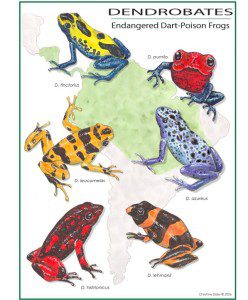Cool Facts About the Dendrobatids
All poison dart frogs belong to the family Dendrobatidae, and all 187+ species reside in the humid rainforests of Central and South America, from Nicaragua to Brazil.
Poison dart frogs are a fascinating group of amphibians with extremely toxic skin secretions. In fact, one species – the golden poison dart frog – is the most toxic land animal in the world. It has enough venom to kill 10 adult men! They’re called dart frogs because historically these toxins were used by native tribes to make their blow darts more lethal to the prey they hunted.

Harlequin Poison Dart Frog, Colombia
Each species is easy to recognize by its unique and beautiful color pattern which signals to potential predators the toxicity of the alkaloid poisons sequestered in granular skin glands. Frogs develop the poisons from their diet of spiders, ants, termites, centipedes, and beetles, but it is unclear whether the poison originates from their prey, or from the diet of the prey items themselves. Interestingly, captive frogs do not have the poison, and some species can easily be raised in captivity and are popular as pets.

Blue Poison Dart Frog, Suriname
Frogs develop the poisons from their diet of alkaloid-rich spiders, ants, termites, centipedes, and beetles. However, it isn’t known whether the poison originates from their prey or from the prey’s diet. Captive frogs do not have the poison, and some species can be easily bred and are popular as pets.
Mating and Raising the Young
Male dart frogs exhibit a variety of courtship rituals to woo the females. Each male will lead his mate to a moist site on the forest floor where he will fertilize a small clutch of about 10 eggs. The reason for such a small clutch soon becomes apparent.
Once the eggs hatch into tadpoles they are carried by the female to a nearby bromeliad plant and there she carefully places each tadpole in a separate leaf axil. Thus, each tadpole resides in its own personal swimming pool nursery and there it resides for 40 days or so as it matures.
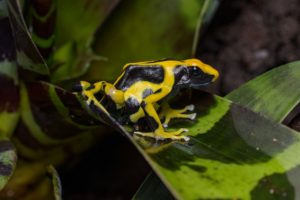
Dart frog on a bromeliad plant
Each day, the female will return to the bromeliad and nourish each tadpole with an unfertilized egg she deposits for it to dine on. So you can imagine how much time and effort the female dedicates and that’s why she only raises a small number of young at once.
Finding Poison Dart Frogs
Dart frogs can be found in a variety of habitats within the countries of Bolivia, Costa Rica, Brazil, Colombia, Ecuador, Venezuela, Suriname, French Guiana, Peru, Panama, Guyana, Nicaragua. As you might imagine, many reside in tropical lowland jungles but others are found in grasslands, shrublands, savannas, and even high elevation cloud forests.
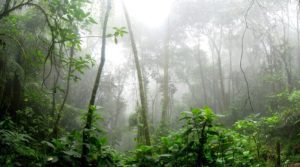
Tropical rainforest habitat
Dart frogs have always been on my ‘target list’ of tropical species to see and were one of the top reasons I recently visited Costa Rica. I had imagined that they would be larger, but once I finally saw one, I was surprised that it was only about as big as my thumb. Once I had honed my ‘search image’ for something that small, I began to spot more.

Christine with a Strawberry Poison Dart Frog
Once seen, they are easy to observe because they don’t hop away like a ‘normal’ frog. Dart frogs have short, stubby legs that only allow them to amble slowly and awkwardly across the forest floor.
They are also easier to see than some other families of frogs in that they are more terrestrial, so they can be found on the ground, as opposed to in the canopy like many other groups of frogs. And finally, being diurnal, dart frogs are active during the day instead of at night, so that’s convenient for us humans!
The Golden Poison Dart Frog
The golden poison dart frog, Phyllobates terribilis, is the most toxic land animal in the world – it has enough venom to kill 10 adult men! This species was used by the Choco people of Colombia to coat the tips of the blow darts used for hunting. A single golden poison frog, only an inch long, can supply enough poison for 30 to 50 darts, and the dart’s poison remains active for up to a year. Researchers have found this frog’s toxins to be 200 times more potent than morphine and could potentially be used in medicine.
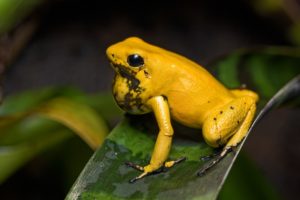
Golden Poison Frog, Colombia
The Strawberry Poison Dart Frog
This is the Strawberry Poison Dart Frog, Oophaga pumilio, also known as the Blue Jeans Frog for obvious reasons. This species of poison dart frog is common, widespread, and often seen due to its diurnal nature. I saw several at a time on my hikes within its range on the eastern side of Costa Rica.
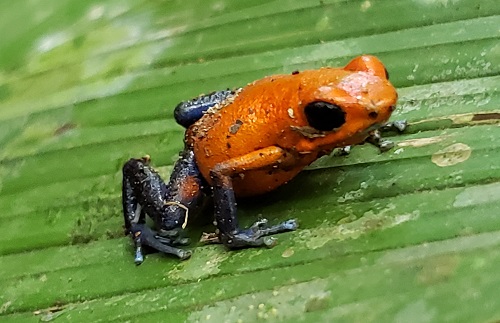
Strawberry Poison Dart Frog, Costa Rica
The males like the one in this photo are terrestrial, so they will generally ascend only as far as a log or small plant, from which they vocalize their territorial and courtship calls. Males of the Strawberry Dart Frog engage in epic wrestling matches to win territories and gain the favor of females.
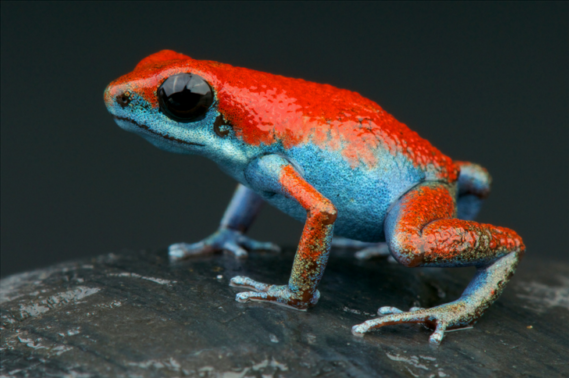
Granular Poison Dart Frog, Panama
Dart Frog Sketching Workshop
Resources for learning more about frogs
Learn More About Poison Dart Frogs
-Why Poison Frogs Don’t Poison Themselves
–San Diego Zoo Dart Frog Information
Learn More About Amphibians
-Amphibian Ark curriculum materials at Amphibian Ark.
-Teacher resources, lesson plans, coloring pages, songs, & fun educational activities about amphibians at Amphibiaweb.
-Conservation website from the Amphibian Survival Alliance & IUCN Amphibian Specialist Group.
-Learn to sketch a red-eyed tree frog.
Download this FROG POSTER I designed that depicts some species of dart frogs.
Endangered Frogs
Many frogs, including poison dart frogs, are threatened with extinction due to the destruction of their rainforest habitat and infections from the chytrid fungus disease.
The video below introduces a movie by the folks at Frog Rescue and Jonathan Kolby, a National Geographic Emerging Explorer who is studying threatened frogs in remote regions of the world. Although his research isn’t focused on poison dart frogs, it highlights the dangers faced by all species of amphibians, including them.
Learn more about his Honduran Amphibian Rescue and Conservation Center.
Did You Enjoy This Story?
If you’ve found value in this story and believe in my mission to educate youth and adults alike on the value of nature, I invite you to make a donation to help broaden and deepen the work I can accomplish.
Click the Paypal ‘Donate’ button below to donate any amount you wish to support the conservation and education work I do. You don’t need to have a Paypal account to donate, you may also choose to use a credit card, or simply send put a check in the mailbox if you wish. Thank you!


